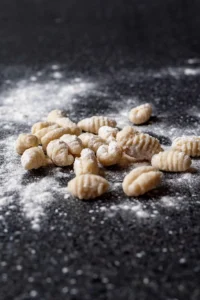The Best Fluffy Pancakes recipe you will fall in love with. Full of tips and tricks to help you make the best pancakes.
Gnocchi is a beloved Italian dish known for its soft, pillowy texture and ability to pair beautifully with a variety of sauces. However, if you follow a gluten-free diet, traditional gnocchi made with wheat flour is off-limits. That’s where this gluten-free Italian gnocchi recipe comes in!
Making gluten-free gnocchi at home may seem challenging, but with the right ingredients, techniques, and a few expert tips, you can achieve the same light and fluffy texture as traditional gnocchi. Whether you’re gluten-intolerant, have celiac disease, or simply prefer gluten-free alternatives, this foolproof recipe will help you master the art of homemade gnocchi.
What Makes Gluten-Free Gnocchi Different from Traditional Gnocchi?
Traditional Italian gnocchi is typically made using potatoes, flour, eggs, and sometimes cheese, creating a soft, dough-like consistency that is easy to roll and shape. However, when switching to a gluten-free gnocchi recipe, the process and texture can change significantly due to the absence of gluten.
1. No Gluten for Structure and Elasticity
Gluten acts as a binding agent in wheat-based gnocchi, providing elasticity and structure. This is what helps the dough hold together without becoming too sticky or crumbly. In gluten-free gnocchi, you must use alternative binding methods, such as eggs, psyllium husk, or xanthan gum, to achieve a similar texture.
2. Flour Substitutions Affect Texture
Wheat flour is commonly replaced with gluten-free flour blends, which often include rice flour, tapioca flour, almond flour, or potato starch. These alternatives absorb moisture differently, making it crucial to find the right balance to prevent gnocchi from becoming too dense or falling apart. A good tip is to use a mix of light and starchy flours to maintain a tender bite.
3. Handling the Dough Requires More Care
Without gluten, the dough is more delicate and prone to breaking apart. You’ll need to gently knead and shape the gnocchi without overworking the dough, as too much handling can make it gummy or heavy. Using the right ratio of ingredients and handling the dough minimally will result in the best texture.
4. Cooking Times May Vary
Gluten-free gnocchi tends to be more delicate when boiled, so it’s essential to cook them just until they float to the surface, which signals that they’re done. Overcooking can cause them to dissolve or become mushy.
By understanding these differences, you can make gluten-free gnocchi that is just as light, pillowy, and delicious as traditional versions!

Essential Ingredients for the Perfect Gluten-Free Italian Gnocchi
Making gluten-free Italian gnocchi requires the right combination of ingredients to achieve a soft, pillowy texture without the elasticity of gluten. Each ingredient plays a crucial role in ensuring your gnocchi holds together while remaining light and fluffy.
1. The Best Potatoes for Gnocchi
Potatoes form the base of most traditional and gluten-free gnocchi recipes. The best varieties are starchy potatoes like Russet potatoes or Yukon Golds, as they have a dry, fluffy texture that helps create a light dough. Waxy potatoes, such as red potatoes, hold too much moisture and can make the dough too sticky.
2. Choosing the Right Gluten-Free Flour Blend
Since traditional wheat flour contains gluten, you’ll need a good gluten-free flour mix for structure. The best options include:
- Rice flour – Light and neutral in flavor.
- Potato starch – Helps create a soft texture.
- Tapioca flour – Adds elasticity to mimic gluten.
- Cornstarch or arrowroot powder – Helps bind the dough together.
A combination of these flours works best rather than using just one type.
3. Binding Agents for Structure
Without gluten, the dough can be fragile. Eggs help bind the ingredients, but for a vegan option, you can use psyllium husk, xanthan gum, or flaxseed meal mixed with water. These ingredients provide extra stability to prevent the gnocchi from falling apart during cooking.
4. Optional Ingredients for Flavor
To enhance the taste, consider adding Parmigiano-Reggiano cheese, olive oil, sea salt, and Italian herbs to the dough. These ingredients will give your gnocchi an authentic Italian flavor.
By selecting the right combination of ingredients, you can create perfect gluten-free gnocchi that rivals the traditional version!
Step-by-Step Guide: How to Make Gluten-Free Gnocchi at Home
Making gluten-free Italian gnocchi at home may seem tricky, but with the right techniques, you can achieve the same soft, pillowy texture as traditional gnocchi. Follow this step-by-step guide for perfect results every time.
1. Preparing the Potatoes
The key to light gnocchi is using the right potatoes. Choose starchy potatoes like Russet or Yukon Golds and cook them properly:
- Boiling method: Boil whole, unpeeled potatoes until fork-tender. Drain and let cool before peeling.
- Baking method (recommended): Bake the potatoes at 400°F (200°C) for about 45 minutes. This removes excess moisture, making the dough easier to handle.
Once cooked, mash or rice the potatoes while they are still warm to avoid lumps.
2. Making the Dough
- In a bowl, combine the mashed potatoes, gluten-free flour blend, and a pinch of salt.
- Add one beaten egg (or a vegan binder like psyllium husk) to help hold the dough together.
- Gently mix the ingredients until they form a soft, slightly sticky dough. Avoid overmixing, as this can make the gnocchi dense.
3. Shaping the Gnocchi
- Lightly flour a surface with gluten-free flour and roll the dough into long ropes.
- Cut into 1-inch (2.5 cm) pieces and press each piece with a fork to create ridges (this helps the sauce cling to the gnocchi).
4. Cooking the Gnocchi
- Bring a large pot of salted water to a boil.
- Drop the gnocchi in small batches; they will float to the surface within 2-3 minutes when fully cooked.
- Remove with a slotted spoon and serve with your favorite sauce.
Best Sauces and Serving Suggestions for Gluten-Free Gnocchi
The beauty of gluten-free Italian gnocchi is that it pairs well with a variety of delicious sauces, making it a versatile dish for any meal. Whether you prefer classic Italian flavors, creamy textures, or lighter options, there’s a sauce to suit every taste.
1. Classic Italian Sauces for Gnocchi
- Tomato Basil Sauce – A simple yet flavorful sauce made with crushed tomatoes, garlic, fresh basil, and olive oil. This pairs beautifully with gnocchi, giving it a traditional Italian taste.
- Brown Butter Sage Sauce – Made by melting butter with fresh sage leaves, this sauce has a nutty, aromatic flavor that complements the soft texture of gnocchi.
- Pesto Sauce – A fresh and vibrant sauce made with basil, pine nuts, garlic, Parmesan cheese, and olive oil. It adds a bold, herbaceous flavor to gluten-free gnocchi.
2. Creamy and Cheesy Sauce Options
- Alfredo Sauce – A rich and indulgent sauce made with butter, heavy cream, and Parmesan cheese, creating a smooth, velvety texture.
- Gorgonzola Cream Sauce – A tangy, cheesy sauce made by melting Gorgonzola cheese into a light cream base, perfect for those who love bold flavors.
3. Light and Healthy Sauce Alternatives
- Garlic and Olive Oil – A minimalist yet flavorful sauce made with sautéed garlic, olive oil, and a pinch of chili flakes.
- Lemon Butter Sauce – A fresh and zesty option made with lemon juice, butter, and parsley, perfect for a light and refreshing meal.
4. Best Side Dishes and Serving Ideas
- Pair gnocchi with a simple green salad or roasted vegetables for a balanced meal.
- Serve alongside grilled chicken, shrimp, or salmon for added protein.
- Garnish with fresh Parmesan, cracked black pepper, or a drizzle of truffle oil for an extra gourmet touch.

Making gluten-free Italian gnocchi at home is a fun and rewarding experience. With the right ingredients and simple steps, you can create light, pillowy gnocchi that’s just as delicious as the traditional version.
Pair it with your favorite sauces, whether it’s a classic tomato basil or a rich brown butter sage, and enjoy a satisfying meal. Experiment with different flavor combinations to find what works best for you.
Now, you’re ready to enjoy a homemade gluten-free gnocchi dish that’s sure to impress!




